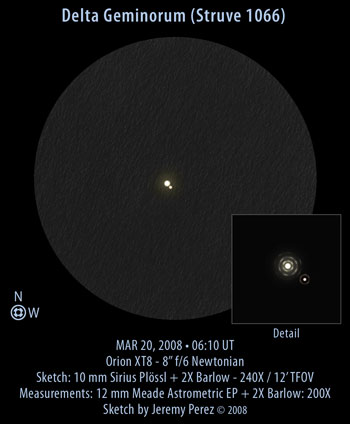
Click image for larger version
Observation Notes:
This double provided a great contrast in magnitude. The secondary was far enough away to not be heavily overpowered by the primary. The 3.5 magnitude primary appeared pale yellow, and the 8.5 magnitude secondary hinted at a dull red color. Since my measurements were made with the XT8 Dobsonian, they are not as accurate as I would like. I measured a PA of 231° which compares to a calculated value of 226.7° for 2008.2. Separation was worse. I measured 9.5 arc seconds with the astrometric eyepiece while the spacing of the diffraction rings indicated 4.5 arc seconds. Not too hot. The calculated value for 2008.2 works out to 5.6 arc seconds. I guess if I averaged my two completely different measurement methods I’d be closer, huh?
| Subject | Delta Geminorum (STF 1066) |
| Classification | Multiple Star |
| Position (J2000) | Gemini [RA: 07:20:07.3 / Dec: +21:58:56]* |
| Position Angle* | 231° [2008.2 my measurement] 227° [2008.2 Brian Workman’s DS Calculator] 224° [1997 Alzner] 220° [1990 WDS] |
| Separation* | 4.5″ [2008.2 my measurement] 5.6″ [2008.2 Brian Workman’s DS Calculator] 5.88″ [1997 Alzner] 5.8″ [1990 WDS] |
| Magnitudes* | 3.5 / 8.5 |
| Spectral Types* | F0 / K6V |
| Date/Time | MAR 19, 2008 – 11:10 PM MST (MAR 20, 2008 – 06:10 UT) |
| Observing Loc. | Phoenix, AZ |
| Instrument | Orion XT8 (203 mm dia./1200 mm F/L) |
| Eyepieces/Mag. | 10 mm Sirius Plössl + 2X Barlow (240X) 12 mm Meade Astrometric EP + 2X Barlow (200X) |
| Conditions | Partly Cloudy (cirrus), Gibbous Moon |
| Seeing | 3/10 Pickering |
| Transparency | NELM Mag ~4.0 |
| *References | The Washington Visual Double Star Catalog, 1996.0 (Worley+, 1996); CCDM (Catalog of Components of Double & Multiple stars (Dommanget+ 2002); Double stars measurements (Alzner 1998); Catalogue of Stellar Spectral Classifications (Skiff, 2007); Brian Workman Double Star Calculator; Starry Night Pro Plus 5.8 |